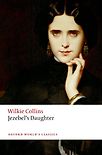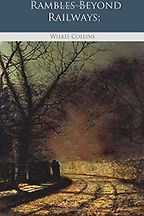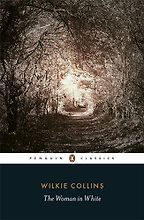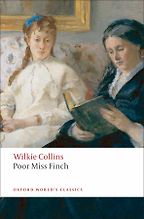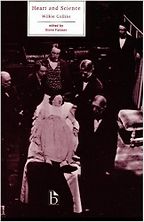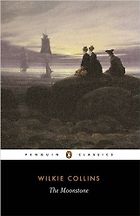Wilkie Collins wrote two incredibly famous books. He said—correctly—that his tombstone would say: “Author of The Woman in White.” Is it worth reading any of his other books?
Oh my gosh, it’s worth reading the other books! Especially if you like The Woman in White and The Moonstone. They are his most famous of course, but if you like weird characters like Count Fosco, or Marian Halcombe—who looks like a man and has a moustache—then his other novels are also full of eccentric characters, oddballs, people from the social margins, disabled characters… characters who just don’t fit in. He gives them a voice; sometimes he gives them the central agency of the plot. It’s their story he’s trying to tell. That really makes his novels stand out, even alongside Dickens, who does weird characters as well.
Do you think Wilkie Collins wrote them because he was so unconventional himself?
Partly. He lived a very unconventional life. He was attracted to distinctive, dramatic personalities. He wrote a little for the stage and I think he always carried with him that sense of dramatic exposition. He knew how to create embodied, fully-rounded characters.
What was unconventional about his life?
Whilst writing all of these novels – and becoming a celebrity alongside Dickens – he maintained two long-term relationships with different women, neither of whom he was married to. One was a widow whose children he effectively raised as his own, the other was a younger women he started a relationship with much later. He led separate lives with each of them, deciding not to marry either one.
Why did he do it? Was it good for the women?
I think it was. But I wouldn’t want to speak for them. By all accounts he was a devoted partner to both of them and a responsible step-parent.
Perhaps he felt marriage was an institution that would shackle him. The novels are very much about the complications arising from the legality, or illegality, of marriage: the paper trail that surrounds it and can prove or disprove its validity. That could be a mirroring of his life and anxieties.
So many of his novels are detective novels, and yet he’s keeping his own life one that’s difficult to detect.
His arrangements were an open secret. But, yes, the idea of having to lead two separate lives, to have two separate identities, to keep secrets, is what he’s interested in in his novels. He called the sensation genre “novels about the secret theatre of home.”
You’ve just edited Jezebel’s Daughter for Oxford’s World Classics. Tell me about this book.
It’s a late novel, published within a decade of his death, in 1880, after he’s had all the success of The Moonstone, The Woman in White, Armadale: the big novels. It was originally a play, performed once only in the 1850s. It was laughed off the stage. It was called The Red Vial and had a fairly uncomplicated poisoning plot. He shelved it and only late in his career decided to adapt it as a novel. It works really well: he fleshes out minor characters, creates subplots, plays down the staginess and gives characters realistic motivations.
“He wrote for the stage – and always carried with him that sense of dramatic exposition”
It’s an interesting novel. It’s got lots of elements people will associate with the big blockbusters of the mid-century: strong, unusual women, murder plots, cloak and dagger mystery scenarios, and a great revelation scene in the Frankfurt dead house. It’s also a novel about strong women, Mrs Wagner and Madame Fontaine, and about middle-aged women. Many of his novels are about young people, young people trying to figure out what happened to their parents, why they’ve become disinherited, why their family name’s no longer their own, how they’re going to get out of a disastrous marriage. But this is about women who have done all of that, and are dealing with legacies, who are raising children, or looking after nephews. It’s an interesting departure in that way.
He’s got strong female characters, and characters who are mentally ill, but also caricatures of menacing foreigners throughout his books. How liberal do you think he was in his views?
Collins was at once forward-thinking, liberal for the nineteenth century, but also a person of his time. He was interested in thinking about the structures and attitudes that disadvantaged people who were different. He liked outsiders and marginal characters, but he was also not above using stereotypes to reach his audience. He can give a lot of sympathy and agency to a mentally ill character such as Jack Straw in Jezebel’s Daughter. At the same time, he can take us to the Jewish ghetto in Frankfurt and give us the complete stereotype that looks like something from Trilby or Oliver Twist.
Then you get characters like Fosco, who you wouldn’t want any other way.
They’re so distinctive, so evil, yet so delectable.
Exactly. Let’s talk about the five books that you’ve chosen by Wilkie Collins. The first is Rambles Beyond Railways (1851). Tell me about it.
I chose this because it’s not the usual fare for people who know a little about Collins. They know him as an author of crazy novels, of the sensation novel. This predates most of that work. It’s a travel narrative: it has elements of his fictional capacity, but it’s really about him and a friend, an artist called Henry Brandling, going into Cornwall on a walking holiday. They’re going into this quasi-mythological world, “beyond the reach of the railway,” which is both true and false. Yes, the mainline of the railway from London hadn’t reached Cornwall by 1851, Brunel’s bridge at Saltash only arrived in 1859, but Cornwall isn’t entirely the back-country they describe it as.
It’s about them going the rounds, seeing the sights, looking at the locals, being looked at themselves as interesting people from the outside, finding out about local customs, and turning this into the kind of adventure that the literary market would consume, an exercise in local colour.
At what stage in his career is he writing it?
Very early, about eight years before the serialisation of The Woman in White, before Basil, before any of the novels that go on to make his name. He’s known as a journalist, but he’s not a commodity in the way that he will be ten years later.
Do these experiences re-emerge in his novels?
You do. He returns to Cornwall in at least two novels. In the climax of Basil there’s a cliff-hanger—literally a cliff-hanger—scene set in Cornwall that uses one of the locations from the tour.
Do you get the sense he’s already fictionalising the landscape?
Very much. The colouring of imagination that Collins throws over the landscape is as interesting to him as what he witnesses. I don’t think he would have ever travelled as a non-writer. He wants to characterise Cornwall as this strange, far-away place where old traditions still survive. They still have a mail coach. When he casts it in his novels, it’s still this place of secrecy, mystery, this foggy place that’s surrounded by the beating Atlantic surf.
Next is The Woman in White (1860). What a fantastic book. Tell me about it.
Where do you start with the story of The Woman in White? What do you do with a novel that has so many strange characters? How do you even begin to define its plot?
One of the big debates surrounding this novel, and sensation fiction more generally, is what the relationship between plot and character is in a novel like this. Is plot the thing that drives you along “as though by steam”—as some contemporary reviewers would say—or do you get captivated by the characters? Some say realistic characters get subordinated by the energy of the plot.
“I’ve read this novel I don’t know how many times, taught it for seven years, and its plot still eludes me”
I’ve read this novel I don’t know how many times, and taught it for at least seven years, and its plot is still something that eludes me. It’s got holes in it, I’m not sure if this person went there first, or if that happened first. But I remember Count Fosco, Marian Halcombe, Walter Hartright, Anne Catherick: the encounter on the high road at the beginning of the novel. There are so many set-pieces and scenes and idiosyncrasies of personality. That’s what keeps me coming back to this novel.
They’re not realistic characters in the way George Eliot would give us, not deep psychological portraits. There’s no omniscient narrator who can penetrate their minds in the way the realist novels gives us. The novel is told to us by a number of narrators—Walter Hartright, Marian Halcombe, Fosco—almost every three chapters they’re switching. The glory of it is you get this story as if it’s a court hearing, everybody is presenting their evidence from their own particular perspectives.
Was this an innovation of Collins’?
Yes. He was not the first person to tell a story with more than one narrator. Dickens had done it with Bleak House in 1853, but he only uses two (an omniscient narrator and Esther Somerson), whereas Collins throws everybody at you: minor characters, people who appear only to tell their tiny bit of the story. It’s something he’ll use again and again throughout his career.
He did legal training, how influenced was he by criminal cases?
Very influenced – he made a point of this in all of the prefaces that deal with a particular point of law: Armadale, The Woman in White, Man and Wife. He wanted to position himself in relation to contemporary legal decisions, in relation to newsworthy stories. One of the things behind novels like The Woman in White was the sensational murder accounts of the time of the novel’s writing.
The position of women in this book surprised me. It seems to be about them being domestically abused. Is this something you think Collins was particularly interested in, or is it naturally part of this Gothic, sensationalist fiction?
I think he was interested in it and, like many people of his time, he was aware that the legislation protecting women within and outside of marriage was not sufficient, that it’s very easy to silence a woman on very spurious grounds. She could be deemed mentally ill or ‘hysterical’ and quite easily put — through a small payment — into a private asylum and locked away forever.
On the surface the novel seems to be a story whereby the trials and tribulations of Laura Fairly are resolved at the end, because Marian Halcombe and Walter Hartright have saved her. But by the end of the novel she’s such a shadow of her former self she might as well be the institutionalised Anne Catherick with whom she was confused. At the end it seems as though Marian Halcombe, the odd, ugly woman of the novel, has endeared herself to both the readers and to Walter to such an extent that the real relationship might be theirs. Laura is this kind of invalid for whom they care.
And it’s so obvious Collins himself is in love with Marian Halcombe.
Readers used to write in to him and say, “Who’s the model for her, where can I meet her?” They thought of Collins as a kind of dating agency.
Next is The Moonstone (1868), another fabulous book, frequently credited as the first detective novel. Why did you choose it?
Like The Woman in White, it’s one of the novels by Collins people are likely to know. It’s another with several characters, lots of perspectives, a great mystery at the middle of it. It’s the first novel that makes detection its whole business; it introduces Sergeant Cuff, a memorable literary detective. But we’d had detective novels before, Bleak House (1853) has Inspector Bucket, who plays a significant role in the second half. And we’d had the Edgar Allan Poe Dupin detective stories (1841-44). So it’s not as if it were operating in a vacuum. It’s fun because it has some of the weirdest characters: Miss Clack the forceful evangelical, for example, who goes around throwing religious tracts at people’s carriages.
And she’s given part of the narrative again, isn’t she? When you read it, you wonder why you’re hearing from this woman.
It’s so diverting for readers to move from an earnest narrator, to a frivolous narrator, or even a crazy narrator.
This was serialised. There’s that very famous quote of Collins’s: “Make ’em laugh, make ’em cry, make ’em wait.”
Exactly, he asks: how do you keep your readers on the edge of their seats? Some of his serialisations ran for a year in weekly instalments.
How is that reflected in the way the books are structured?
Having edited one of them, I can see it first-hand. I consulted the manuscript of Jezebel’s Daughter as well as the original serialised version, the three-volume edition, and the one-volume edition. He clearly knows how to write in serialised form, and how that form will then translate into a novel. You can see how he breaks it up. He even inserts in his manuscripts “stop here,” or “end of serialisation part 1.” He internalises that frequency of writing. It’s about having this many words to fill per instalment and needing to introduce a scenario, a few characters, to leave the reader with something to make them come back. He’s very good at building intensity, diminishing it, building it up again, and staging that out across the weeks.
He was addicted to laudanum, as a treatment for gout; an addiction like it appears in the character of Ezra Jennings. Did his illness and addiction influence his writing?
It affected how he was able to write. Illness and addiction to pain relief keep you from your desk. For a writer whose money comes in because he delivers on time and delivers a lot, this was a real concern. He battled throughout his life with the ups and downs this addiction produced.
Poor Miss Finch is next. It’s from 1872, another later one. Tell me about this book.
This is one of my favourite Collins novels, because it’s very funny and very touching. It’s about a woman called Lucilla Finch, who is blind from early in her life due to cataracts. Through a radical surgical operation she has her sight restored, only to lose it again. There’s a lot that interests me from the perspective of Victorian science: speculative, abstract science as represented by the English surgeon Mr Sebright versus the radical physiological empiricism of Herr Grosse in the novel, the German oculist. But then there’s also a story about two twin brothers, Oscar and Nugent Dubourg, one of whom as a result for taking medicine for epilepsy turns his skin blue, and is blue for the whole course of the novel. That you find only in a Collins novel: a character who is blue throughout.
“He battled throughout his life with the ups and downs of his addiction ”
There’s also, of course, the minor character Jicks: a strange child who goes around talking about herself in the third person (“Here comes Jicks…”). Miss Finch herself is centre-stage as this beautiful, captivating woman with a disability, who wins over readers and the other characters. She’s not the only character with a physical disability to be central in one of Collins’s novels. Hide and Seek has a woman who’s deaf and mute, in The Law and the Lady there’s Miserrimus Dexter, who has no legs.
Collins seems to be searching for people who are marginalised. Do you think he’s interested in them and their plight, or do they just make for good characters?
Both. He realises they make good characters and he makes a career on idiosyncratic characters, even caricatures. But I think he’s also really just interested in giving them a voice. These are characters who are either only minor in other novels, or there for comic relief. Yet he asks: what’s it like to tell the story from the perspective of someone who’s been blind for life, or someone who’s not been able to hear for life?
This also seems to feed into his interest in science, especially in the mysterious elements of science, which are also linked to foreignness.
It is often linked with foreigners in the novels, whether it’s Herr Grosse bringing his radical, possibly dangerous surgical techniques to England, or the poisonous designs of Madame Fontaine in Jezebel’s Daughter, or the English but foreign-sounding Doctor Benjulia in Heart and Science.
Count Fosco is a chemist.
And an exiled, Italian, secret-society member.
Is this a Collins thing, or just a Victorian thing?
It’s both. There was a real anxiety in the British popular imagination in the nineteenth century about science… France and Germany were associated in the popular mind with dangerous science, with experimental science, with experimentation on animals and even, if left unchecked by law, experimentation on humans.
Is it a way of dealing with science, of saying, ‘we want unlimited progress, so we’re going to expel the nastier end of the spectrum by making it foreign’?
Yes, it’s British Victorians saying they want its benefits, but don’t want the experimentation itself in their own garden. Which is why Benjulia in Heart and Science is so frightening, because he’s right there on the outskirts of London doing his work on monkeys and dogs in a warehouse.
Tell me about more about Heart and Science.
It’s very much a thesis novel. Heart and Science is Collins’s 1883 attempt to enter directly into the anti-vivisection debates, which were very hot at that moment. There had been a number of texts by continental doctors published in translation, which were very explicit about the vivisectionist as this artist of murder who doesn’t hear the cries of pain. This scared the hell out of middle-class England, and even many in the mainstream medical establishment in Britain.
Collins was sensitive to animals, and sensitive generally to suffering, as his novels show. He wanted to show in this novel that there’s a fine line between disregarding animal suffering and being cruel as a human.
Does it work also as a novel?
Just. It does work as a novel, in fact it’s a lot of fun in places, it has great characters but it is very didactic. Which isn’t to say it doesn’t tell a good story.
What’s the plot?
It’s about a young student of medicine who is working himself into the ground and needs to take a break, and when he’s going to do that runs into a woman who could be a romantic interest, and they begin a complicated plot whereby she becomes disabled (she suffers a medical ailment) only to be stalked by Dr Benjulia, the experimental doctor, hoping to learn something that will help him in his experimental aims by artificially prolonging her illness. It’s a contest to save her but to also find a solution to the medical problem she presents, and whether experimental means or other means are best suited to that purpose.
“There’s a fine line between disregarding animal suffering and being cruel as a human”
Benjulia’s brother serves as a means of vocalising the plight of the vivisectionist. They have conversations about whether the dog will complain, whether animals have a language in which to address their complaints about being operated on. At the end of the novel there’s a famous scene in which he lets the animals go and they all come flooding out before his demise.
Finally, what do you think Collins changed most about the way the novel was written?
He showed us not to be afraid to experiment with narrative form: you don’t have to tell it either from the conventional first-person, eye-witness perspective, the conventional Bildungsroman formula, or from the omniscient narrator’s perspective. You can have characters speak for themselves, you can have lots of them, you can mix them up, and the readers will be excited by that. You can have non-conventional characters front and centre and readers will be compelled by something other than normal men and women moving towards marriage.
Five Books aims to keep its book recommendations and interviews up to date. If you are the interviewee and would like to update your choice of books (or even just what you say about them) please email us at [email protected]
Five Books interviews are expensive to produce. If you've enjoyed this interview, please support us by donating a small amount.

